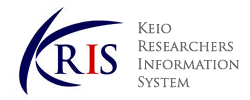-
Affiliation
-
Faculty of Science and Technology, Department of Applied Chemistry (Yagami)
-
Position
-
Professor
-
Related Websites

KEIO RESEARCHERS INFORMATION SYSTEM |
Details of a Researcher
このページはJavascriptを使用しています。すべての機能を使用するためにはJavascript を有効にする必要があります。
Yoshioka, Naoki
|
|
|
π電子系有機固体の磁気特性を中心とした電子物性を分子機能材料への応用を念頭において探求している。安定有機ラジカル、遷移金属錯体、共役高分子などを研究対象として、分子系におけるスピン整列のメカニズムを明らかにしながら分子工学的なアプローチで分子磁性体を構築するための集積技術の確立を目指している。具体的には、以下の研究課題に取り組んでいる。
(1)非共役骨格を介した分子内スピン整列挙動を活用した分子強磁性体の構築
(2)分岐したπ共役系を活用した高スピン分子の設計
(3)金属-非金属間多重結合とアキシアル自己集積を活用した単一金属強磁性連鎖の構築
(4)ラジカル前駆体の電子状態を利用した有機蛍光色素の開発
(5)ポリラジカル高分子の電子構造解析と機能物性評価
早稲田大学/日本学術振興会(理工学部) ,特別研究員
日本学術振興会(Massachusetts大学) ,海外特別研究員
慶應義塾大学(理工学部) ,助手
慶應義塾大学(理工学部) ,専任講師
慶應義塾大学(理工学部) ,助教授
Waseda University, Faculty of Science and Engineering, 応用化学科
University, Graduated
Waseda University, Graduate School, Division of Science and Engineering, 応用化学専攻
Graduate School, Completed, Master's course
Waseda University, Graduate School, Division of Science and Engineering, 応用化学専攻
Graduate School, Completed, Doctoral course
Nanotechnology/Materials / Functional solid state chemistry (Functional organic material chemistry)
Nanotechnology/Materials / Organic functional materials (分子磁性)
Nanotechnology/Materials / Polymer chemistry (機能性高分子)
Molecule-Based Magnetism
Magnetochemistry
Crystal Chemistry
Structure=Function Correlation
Construction of ferromagnetic molecular assembly,
Synthetic chemistry of stable organic radical,
非共役骨格を介した磁気的相互作用を利用した基底多重項分子の設計,
強磁性スピン整列を安定化させる縮環共役骨格の探索,
Self-assembly of metal complex and their magnetic characterization,
Characterization of pi-conjugated organic solids
Interested in joint research with industry (including private organizations, etc.), Desired form: Technical Consultation, Funded Research, Cooperative Research
Advances in Organic Crystal Chemistry: Comprehensive Reviews 2025 on Crystal Functions
Naoki Yoshioka, Youhei Miura, Masaomi Takii, 2025.08, Page: 278
Advances in Organic Crystal Chemistry
YOSHIOKA NAOKI, Springer-Verlag GmbH, 2015.08
Scope: 669-688
Magnetic Properties of Organic Materials
吉岡直樹、井上秀成, Marcel Dekker, 1999.05
Scope: 553-572
電子機能
西出宏之, 吉岡直樹, 土田英俊, 学会出版センター, 1990.04
Scope: 125-156
Miura Y., Mohri K., Funayama D., Yoshioka N.
European Journal of Organic Chemistry 27 ( 46 ) 2024.12
ISSN 1434193X
Hydrogen-Bonded Cyclic Tetramer Formation of a Pyridylethynylimidazole-Based Fluorophore
Miura Y., Murai K., Ando N., Yoshioka N.
Chemistryselect 9 ( 38 ) 2024.10
A Nitronyl Nitroxide-Substituted Benzotriazinyl Tetraradical**
Tretyakov E.V., Zayakin I.A., Dmitriev A.A., Fedin M.V., Romanenko G.V., Bogomyakov A.S., Akyeva A.Y., Syroeshkin M.A., Yoshioka N., Gritsan N.P.
Chemistry A European Journal 30 ( 8 ) 2024.02
ISSN 09476539
Miura Y., Takeda T., Yoshioka N., Akutagawa T.
Crystal Growth and Design 22 ( 10 ) 5904 - 5911 2022.10
ISSN 15287483
Youhei Miura,Kazuki Murai, Kazufumi Yamada, Naoki Yoshioka
Bulletin of the Chemical Society of Japan (公益社団法人 日本化学会) 94 ( 10 ) 2444 - 2450 2021.09
Research paper (scientific journal), Joint Work, Accepted, ISSN 00092673
Synthetic studies of xanthine derivatives and their analysis of molecular and electronic structures
Yoshioka, Naoki
学事振興資金研究成果実績報告書 (慶應義塾大学) 2023
Yoshioka, Naoki
科学研究費補助金研究成果報告書 2022
Molecular design of conducting polymer materials containing localized radical center
Yoshioka, Naoki
学事振興資金研究成果実績報告書 (慶應義塾大学) 2017
Construction of high dimensional magnetic network by using spiro-conjugated unpaired electrons
Yoshioka, Naoki
科学研究費補助金研究成果報告書 2015
Construction of spin network by chemical modification of organic radical self-assemblies
Yoshioka, Naoki
科学研究費補助金研究成果報告書 2011
ニトロニルニトロキシド有機固体における磁気的相互作用-水素結合を用いたアプローチー
長島英明、吉岡直樹
日本結晶学会誌 46 ( 5 ) 364 - 369 2004.05
Article, review, commentary, editorial, etc. (scientific journal), Joint Work
磁性分子集合体-水素結合を利用したアプローチ-
長島英明、吉岡直樹
表面 41 ( 3 ) 89 - 95 2003.09
Article, review, commentary, editorial, etc. (trade magazine, newspaper, online media), Joint Work
21世紀の新しい分子機能材料
化学工業 ( 1月号 ) 11 - 16 2001.01
Article, review, commentary, editorial, etc. (trade magazine, newspaper, online media), Single Work
高スピン系磁性材料
吉岡直樹、西出宏之
機能材料 18 59-68 1998.09
Article, review, commentary, editorial, etc. (trade magazine, newspaper, online media), Joint Work
水素結合を利用したニトロキシドラジカルの集積化とLB膜の作製
表面科学 19 244 - 248 1998.04
Article, review, commentary, editorial, etc. (trade magazine, newspaper, online media), Single Work
種々の置換基を導入した4-アリールエチニル-5-ベンゾイルイミダゾール誘導体の結晶で観測される自己回復性メカノフルオロクロミズム
毛利 匡佑、三浦 洋平、吉岡 直樹
[Domestic presentation] 日本化学会第102春季年会 (オンライン 15:00 〜 15:10) ,
Oral presentation (general)
インドールおよびベンズイミダゾールニトロニルニトロキシドの集積構造および磁気特性に及ぼすメチル基導入の効果
久冨 雄大、目見田 捷俊、佐久間 聡、三浦 洋平、吉岡 直樹
[Domestic presentation] 日本化学会第102春季年会 (オンライン) ,
Oral presentation (general)
長鎖置換基を導入した5-アリールエチニル-4-(2-ピリジルエチニル)イミダゾールの超分子形成と蛍光特性
安藤 直行、村井 一貴、三浦 洋平、吉岡 直樹
[Domestic presentation] 日本化学会第102春季年会 (オンライン) ,
Poster presentation
相転移を示さない5-Fluorobenzoyl-4-methoxyphenylethynyl-1-methylimidazole結晶のThermosalient効果
三浦 洋平、武田 貴志、芥川 智行、吉岡 直樹
[Domestic presentation] 日本化学会第102春季年会 (オンライン) ,
Oral presentation (general)
四座シッフ塩基ニトリドクロム(V)錯体の集積および磁気特性に及ぼす配位子導入置換基の効果
坂 健人、石田 そのみ、柴田 晃太郎、三浦 洋平、吉岡 直樹
[Domestic presentation] 日本化学会第102春季年会 (オンライン) ,
Oral presentation (general)
Construction of Metal-fFee Magnetic Materials Containing Biphenylene Unit
挑戦的研究(萌芽), Principal investigator
局在ニトロキシドラジカル骨格を含むπ共役系ポリマーを基盤とする磁性半導体の創製
MEXT,JSPS, Grant-in-Aid for Scientific Research, Grant-in-Aid for Scientific Research (C), Principal investigator
Construction of High Dimensional Magnetic Network by Using Spiro-Conjugated Unpaired Electrons
Grant-in-Aid for Scientific Research, Yoshioka Naoki, 挑戦的萌芽研究, No Setting
水素結合を利用した強磁性ニトロキシラジカル集積体の開発
Grant-in-Aid for Scientific Research, Yoshioka Naoki, Research grant, Principal investigator
リチウムイオン二次電池の安全性を高めるレドックス・シャトル剤の分子設計と電解質への応用
研究成果最適展開支援プログラム(A-STEP) フィージビリティスタディ(シーズ顕在化), Commissioned research, No Setting
光電変換素子及びΠ共役型有機ラジカル化合物
Date applied: 特願2011-104225 2011.05
Date issued: 特許第5996255号 2016.09
Patent, Joint
TOPICS IN PHYSICAL ORGANIC CHEMISTRY
2025
SEMINAR IN APPLIED CHEMISTRY
2025
MATERIAL SCIENCE 2
2025
LABORATORIES IN APPLIED CHEMISTRY C
2025
INDEPENDENT STUDY ON FUNDAMENTAL SCIENCE AND TECHNOLOGY
2025
応用化学計算基礎
Keio University
Autumn Semester, Lecture, 1h
Pacifichem 2025 #MAT011 Organizer
(Honolulu) ,
日本化学会,
高分子学会,
日本磁気学会,
日本化学会有機結晶部会,
日本化学会 ケモインフォマチックス部会,
部会長, 日本化学会 有機結晶部会
主査, 日本化学会 有機結晶ディビジョン
実行委員長, 第29回有機結晶シンポジウム 実行委員会
副部会長, 日本化学会 有機結晶部会
幹事, 日本化学会 有機結晶部会